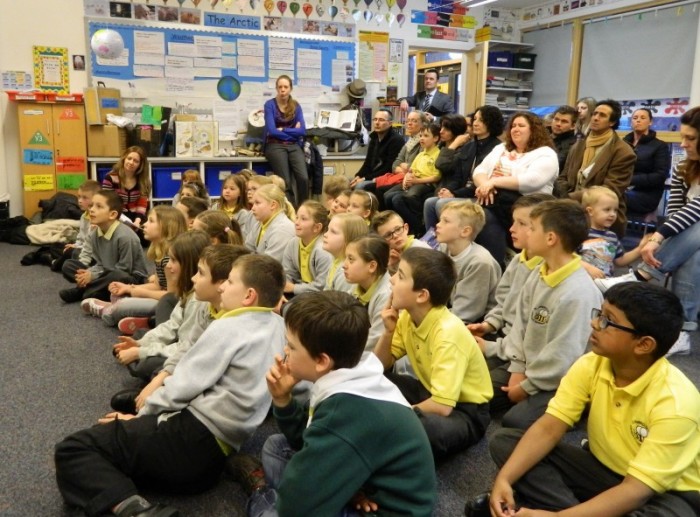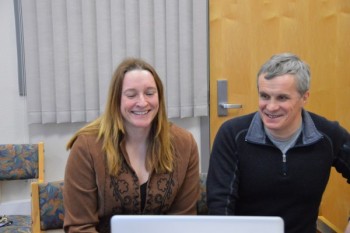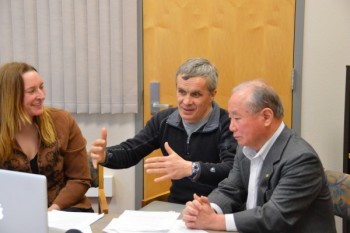UK kids 'meet' Arctic climate scientists
April 9, 2015

Yuri Bult-Ito
907-474-2462
4/9/2015
A group of elementary school students recently had a rare opportunity to ask scientists questions directly about the Arctic and climate change.
Seven- to 9-year-olds and their parents packed a classroom in Worcestershire, U.K., to meet on Skype with scientists at the University of Alaska Fairbanks International Arctic Research Center.
Students spent several weeks learning about climate change and how human activities may affect the environment, so they had many questions.
“If polar bears are the top of the food chain, what is at the bottom?”
“Why are there no penguins in the Arctic?”
“Is the Arctic just water and ice, or are there other types of rocks there?"
“What is the impact of 24-hour daylight and 24-hour darkness?”
“How do the northern lights have colors in them? How does it happen?”
“If you were to throw water into the air, would it freeze immediately?”
“What type of resources does the Arctic have?”
“What will the impact of climate change be on the rest of the world?”
Georgina Gibson, who studies marine ecosystems, talked about the marine food chain: phytoplankton, zooplankton, fish, seals, polar bears. She explained how animals can survive in the cold water. Fish have special proteins in their blood that work as “antifreeze,” while mammals have a lot of fat to help keep them warm.

Syun-Ichi Akasofu, an expert in aurora research, compared the northern lights with a neon sign; an electric discharge with energy coming from the sun causes the aurora. The most common color in the aurora is whitish green or greenish white, which comes from atomic oxygen.
Vladimir Alexeev, an atmospheric scientist, tackled questions about why the Arctic is melting and explained the differences between the Arctic and Antarctica.
Elena Sparrow, who specializes in soil microbiology, talked about different types of soil. In response to a question about how climate change can be slowed down, Sparrow pointed out concrete steps anyone can take, such as turning off lights and unplugging electric gadgets when not in use, using recycled materials and energy-efficient appliances, and consuming locally grown vegetables and fruits instead of packaged goods.

Some questions touched upon what the students may experience when they grow up, which prompted a conversation about how scientists construct and use models to make better estimates of the future as well as the reality that there are still many unknowns and that there are different opinions about climate change among scientists.
The students were excited about the opportunity to ask questions and receive feedback in real time, noted Polly Montague, a teacher who had contacted IARC originally.
After the meeting, one student said, “It had lots of interesting facts and it gave me the confidence to become a scientist.”
“I thought it was brilliant, because whatever we asked, the scientists knew the answer,” said another.
The meeting inspired the parents and teachers as well. “Thank goodness the world has dedicated, knowledgeable people who inspire others. The spark in their eyes and the passion in their hearts inspired me to do all in my power to support the great work they are doing,” said Montague.

The enthusiasm shared by the students and the researchers was mutual. “Working with kids is fun," Alexeev said. "They may have a completely different point of view. That makes us think.”
Gibson agreed. “It is fun to hear what kids are interested in," she said. "Why do people care about what we scientists do? I’m an ecosystem modeler and I enjoy working with other scientists and modelers. But learning about what the public cares about makes me think about how to better relate my research to the bigger picture.
“Talking with the U.K. kids was another such great opportunity,” she said.
NOTE TO EDITORS: Photos in high resolution are available upon request.
YB/4-9-15/245-15


